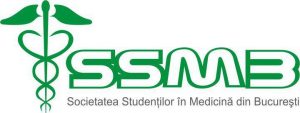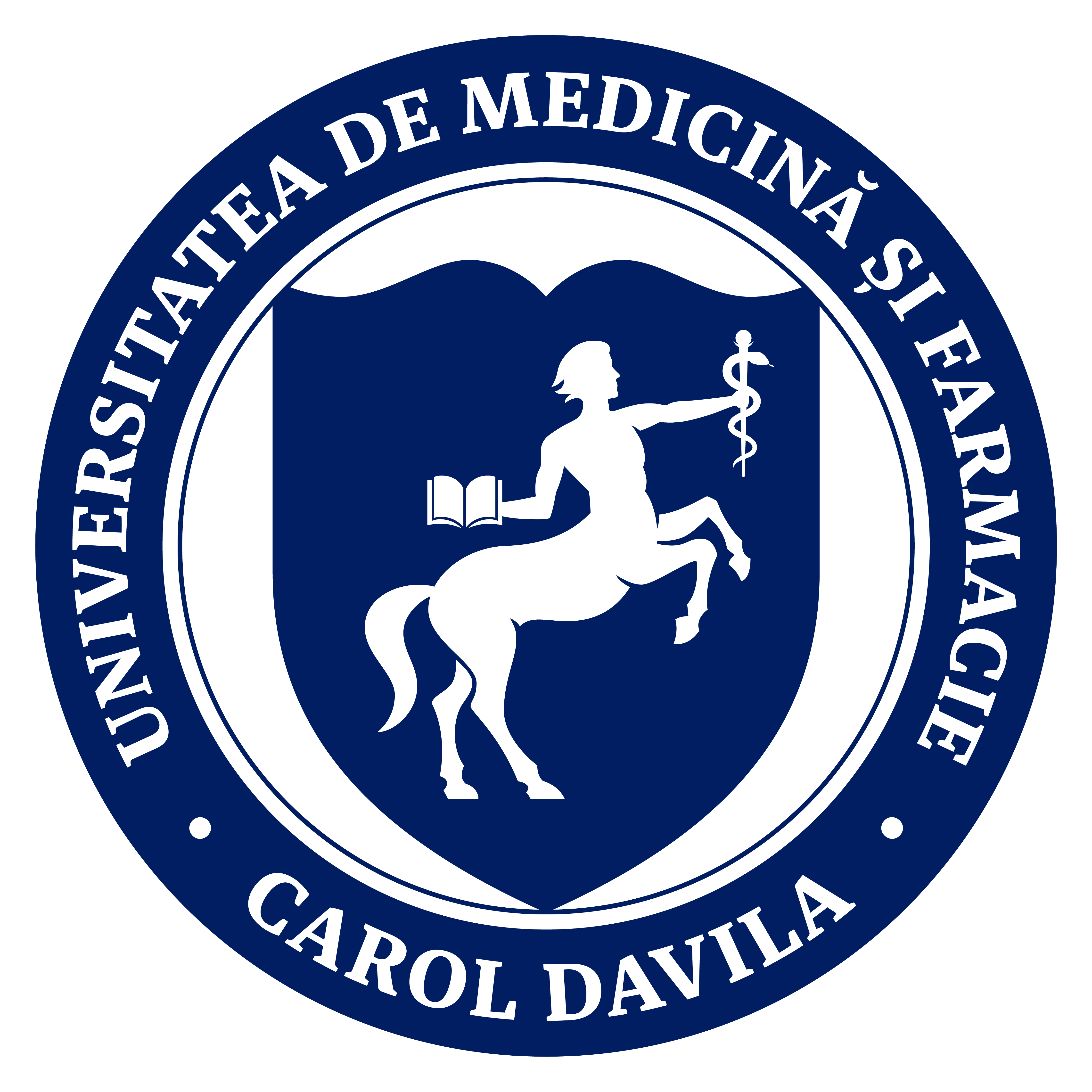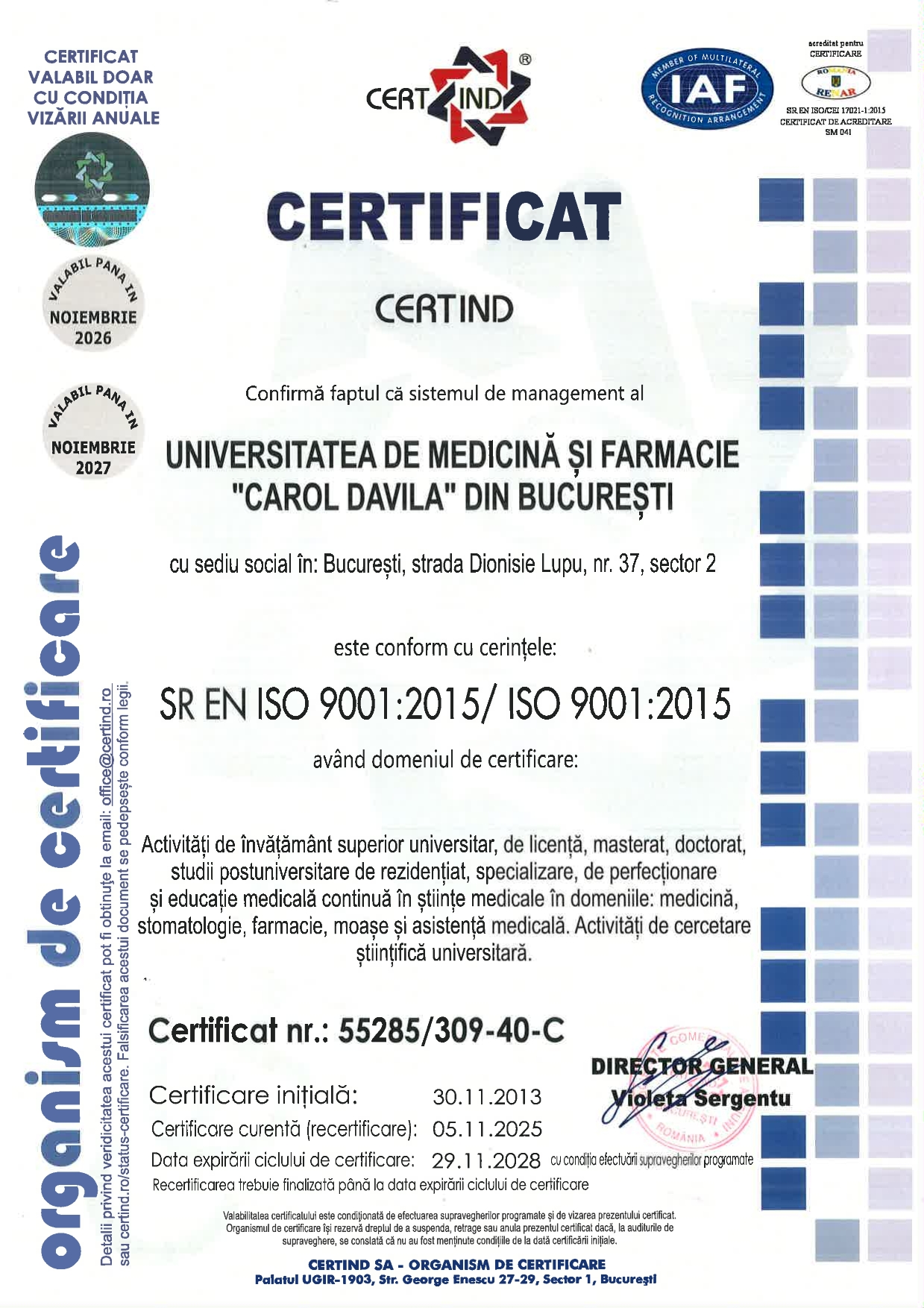- About UMPCD
- Education
- Students
- Research and development
- International relations

The Medical Students’ Society of Bucharest, also known as SSM or SSMB, was founded on January 1st/13th, 1875, six years after the foundation of the Faculty of Medicine in Bucharest and eighteen years after the first medical scientific society in Bucharest (The Medical Scientific Society – 1875).
It was formed out of the students’ need and willingness to support each other, to exchange ideas in an organised manner and, most importantly, due to the need for rigorous scientific documentation in an age when Romanian medical literature was at its very beginnings, and neither public, nor University libraries were able to provide the books and journals required for the adequate training of future doctors. The advocate of this idea was Nicolae Manolescu, then a student, who was to become an illustrious professor of ophthalmology at the Faculty of Medicine in Bucharest.
The Founding of the Society (1875)
On January 1st (Old Style date) / 13th (New Style date), 1875, a group of students laid the foundation of this society. Here is professor Manolescu’s account of the difficulties he had encountered during his studies, which led to his initiative:
‘Poor as I was, I was not able to purchase the necessary books, nor could I afford the luxury of a subscription to a medical journal; out of my desire to read new articles, I decided to borrow 10 lei from a few of my friends and as soon as I had collected 100 lei, I paid for a subscription to the ‘Archives Physiologiques’. However, as I was neither able, nor willing to give the money back to my lenders, as soon as the journal arrived, I placed it at their disposal, announcing my decision regarding the debt. A number of inconveniences came to light at once, chief among them being the fact that the journal would break apart before everybody had had a chance to read it. Hence arose the model of a small society to which everybody would contribute their books, thus enabling us all to read them. I shared this proposal with Istrati, Boicescu, Argeșanu, Manicea, Steuceanu, Butărescu, Filibiliu, Pastia, Bejan and others and so, on January 1st, 1875, we founded the Students’ Society in Romania, the first of its kind in our country.’
The Medical Students’ Society comprised, at first, ten founding members (Nicolae Manolescu, Constantin Istrati, Sterie Argeșeanu, Alexandru Boicescu, Constantin Steuceanu, George Pastia and Vasile Vasiliu Bejan), plus nine students who signed up later on; it held its first public meeting on February 16th, 1875, with Alexandru Boicescu as its temporary president. During this first meeting, the 27-article statute book was voted, the Society committee was chosen, and the presidency was bestowed on Nicolae Manolescu.
According to the statute book, the Society comprised active, corresponding and honorific members. The active members were students at the Faculty of Medicine; additionally, students at the Faculty of Science, as well as the Higher Farmacy or Veterinary Schools were also allowed membership. Corresponding members were students at other faculties, while honorific members were former members and individuals who contributed to its succes by helping and providing study material for medical students. Notable honorific members of the society were: Eforul Ghica, Carol Davila, Nicolae Manolescu, Nicolae Kretzulescu, Gheorghe Grozovici, Constantin Cantacuziono, Alexandru Obregia, George Pastia, Gheorghe Marinescu, C. Marcovci, Mina Minovici, Theodor Ionescu, Ernest Juvara and many others.
During the meeting on March 9th, 1875, Nicolae Manolescu presented his dissertation on “Cholera”, thus inaugurating a series of Society conferences; these, alongside Istrate’s conferences “On Romania From A Medical Point of View” and on “The Medical Parnassus”, would form the basis on which the whole edifice of scientific activity within the society was built.
1875-1948 – The War of Independence
In 1876, C.I. Istrati became president of the Society. In April 1877, all activity was suspended as the members became actively involved in the war of Independence – “the soldiers in white”, as the doctors and auxiliary staff who organised and comprised the Sanitary Corps of the Army were called.
Istrati, president at the time, declared: “Due to political events, the cannon has replaced the voice of reason and rights – and when the motherland summoned her sons, to count them and thus oppose force to force and cannon to cannon, medical students, the members of our young Society, were quick to answer its call. Together with other students at the University, they formed columns, signed up as volunteers and went wherever the voice of their country directed them”.
Therefore, during the last meeting, held on April 14th, 1877, the following decision was agreed upon: “On account of the stirring events taking place in our country, and seeing as almost all the members of this Society are leaving for the battlefield, we hereby decide to suspend the activity of the Society indefinitely, until its members return in sufficient numbers”.
1878-1916
The activity of the Society resumed on January 29th, 1878. A significant number of new members signed up, contacts were formed with libraries in Paris, the Hirschfeld dictionary was purchased and subscriptions to the journals ’Paris medical’ and ’Gazette des Hopitaux’ were bought.
The scientific activity expanded significantly: during its first three years, the maximum number of scientific reports had been 10, in 1876; after 1878, it increased steadily, up to 33 in the year 1882. Moreover, the number of active members went from the initial 10 founders in 1875, to no less than 267, only 25 years later.
Relations were formed with fellow students’ societies: the Italian Students’ Society in Naples, ’Iulia’ Reading Society of Romanian youth at the University of Cluj, ’Junimea’ Academic Society – Romanian branch of the Francisco-Josephine University in Cernăuți, ’Romanian Youth’ Scientific and Literary Society, ’Unirea’ University Society.
The ’Hospital’ journal
In January 1881, the members of the society edited the first issue of the ‘Hospital’ journal, a journal consisting of scientific addresses, appearing monthly and with a subscription-based distribution. It was the first scientific journal edited in Romania.
The development of the Society, its registration as a legal entity, the library
On the 26th of March 1881, the Romanian Academy, through the address no. 175, took the Bucharest Medicine Students’ Society under its’ protection, offering to provide them with a copy of all its periodical publications. In 1896 (21 years after its foundation) the Society was awarded the title of Moral and Legal Person by law, voted by the Romanian Parliament, and was promoted by the King Carol I, in approval and appreciation of its activity.
In the following years, the Medical Students’ Society continued to develop, with the students’ interest increasing exponentially, resulting in over 30 years of conferences and clinical observations in 1897, and throughout 1899, 81 scientific communications took place. To stimulate the members’ interest, the committee introduced monthly prizes for the best paper on a certain subject, besides the previously introduced yearly prizes. Also, short 15 minute presentations were adopted, in the form of presenting patients, pathology slides, microscopy slides, photographs and drawings, all these being highly appreciated by the attending public.
A key element in the development of the Society was the library: from a few issues of ‘Archives Physiologiques’, by the end of the year 1900, it had evolved into an exquisite library, owned by the Society. In 1945, it was seized by Communist forces. To ease the work of those willing to consult this material, Tache Ionescu – former liberal minister of Public Education – printed in 1896, on behalf of the Ministry, the catalogue of the library in 1000 copies. The following year an appendix for the catalogue was published, including doctor Polizu’s donation.
‘Exhibition for advancing and spreading of sciences’
The Society’s president at the time, G. Stoicescu, along with the Committee, decided to present the Society at the ‘Exhibition for advancing and spreading of sciences’, which was organized in 1903, led by one of the first presidents of the Society, C. Istrate. In a cupboard, the Society (including the ‘Hospital’ journal) presented to the visitors their whole activity and its results: alongside a collection of journals, excerpts and original papers, there were exhibited papers awarded within the Society, a catalogue of the library, surrounded by a small anatomical pathology museum. For these, the Society was awarded the gold medal and a collaborator certificate.
On the Society, in the early XX century press
The newspapers of the time wrote: ‘Among the Students’ Societies, the one which produces the least fuss, the one which is talked about the least, is the Medical Students’ Society. But as little as it was spoken about this Society, as much it had accomplished and continues to do so for the learning of its members, to ease their studies and deepen the friendship and comradeship among them. Such a Students’ Society deserves everyone’s approval and will certainly have it.’
The 1906-1915 period and celebrating 40 years since the Society’s establishment
The Society experienced a tremendous development: in 1906 it counted 395 members, 19,000 books in the library and a fund of 23,000 lei. In 1915 it reached 30,000 scientific books, 70,000 lei and a domain for its own building.
Founding members of the Society in 1875
In 1915, celebrating the 40th anniversary of the Society, under Victor Papilian as president (later a professor at the University of Medicine in Cluj), a 80-page commemorative book was published, including the photograph of the first committee from 1875, the last committee from 1915 and photographs of all the presidents (in the order of Society leadership), with a dedication from each and the following foreword, written by the committee:
‘The Medical Students’ Society is 40 today! Stemming from a generation still represented today, the Medical students’ Society is the result of a continuity of ideas and visions, an unspoken understanding between souls, vibrating in a unifying effort towards the same goal… Another string of generations saw in this Society a small room, with a few books and journals, while others craved a larger library, and the latest generations found themselves an ideal, which chases completion: their own building.
A Students’ Society managed to achieve, in a time of undue individualism, 40 years of a strong and fruitful life, with the title of moral and legal entity, 30 000 scientific books, almost 70 000 lei and a domain for its own building! A society that keeps close to itself, as honorary members, all its former members – nowadays doctors, university professors, academicians, scholars, ministers…
A students’ society with hundreds of active members, it grew into a hotspot of scientific culture – similarly for professors, doctors and students. The beauty in the life of this Society is precisely the unbroken bond a member has with it. From this bond, the determination of the leaders and members flourished, and furthermore it led to the strong organization the Society shall always possess.
The mystery of the careful management and the perpetually beautiful life of the Society can be explained by the selflessness all its leaders have shown working only for the Society, and not for themselves. Forty years of existence and just as many of struggle, unrest and enthusiasm! Out of all these, the strengthening of characters and installation of the justice, greater good and spirit of truth resulted. Together these led, in our Society, to a solidarity based on great love and the establishment of friendship and honesty!
In the year 1915, The Medical Students’ Society, climbing the 40th stair, in the blazing sunlight, has proven how far one can reach through hard work, seriousness and love. This 40th year is neither the last, nor the peak, just one more year leading the Society into eternity. We can foresee a brilliant future for our Society, soon settled in its own palace. With its beautiful and fruitful life, The Medical Students’ Society is tirelessly writing its golden book. Today, when we find ourselves in its 40th year, the same thought interests us all: the past of the Society. May we allow now our ancestors to speak… listening to them: so many distinguished souls, and how many wonderful things…’
The interwar period
On 17/30 November 1918, the Medical Students’ Society held its first plenary session after the war, which was attended by 46 active members and three honorary members (V. Gomoiu I. Jianu, T. Gane). In November 1919, as a sign of high appreciation of the work performed, the Society was invited to the inauguration of the French University of Strasbourg and on 22nd of November 1919, the President of the Society at that time, Marius Georgescu, was elected Vice-President of the International Confederation of Students.
In 1924, The Medical Students’ Society, under the Presidency of Ion Simionescu, celebrated, in Civilian Hospitals’ Hall of Eforie, 90 years after the establishment of the first ‘Sanitary School’ in Romania – Faculty of Medicine in Bucharest.
The 50th anniversary
In 1925, at the 50th anniversary of the Society, the President at that time, Constantin Danulescu wrote: ‘The Medical Students’ Society from Bucharest, a hotbed of scientific culture, excitement purely national and beautiful ideal, embracing all student life manifestations, celebrates this year 50 years of existence!
Starting from tacit support and efforts of several great souls and dreamy – all missing today – which they knew how to instill yet from the beginning, by their unselfish, enthusiastic, immortality, it has become through hard work, commitment and love for good of the 50 generations that have succeeded not only the most powerful students’ organization in Romania, but also one of the richest and most impressive societies in Europe. From its initiative, took existence all other student societies, missing or existing in the country.
It was the first that understood at the appropriate time the significance of various Romanian students associations abroad and fought with enthusiasm and generosity for national and cultural unity of all Romanians. Its past, rich in so many beautiful, noble deeds and colorful fruits, speaks abundantly.
At present, by the strengthening of character as well as by intensifying intellectual life, specifically Romanian, it is that which gives the honest and generous impulse to all student life in the country and by the completion its magnificent own palace, will be able to really win rightful citizenship as any high cultural institution of the State. Given under its care the appearance of the oldest scientific Romanian publications, the magazine ‘Hospital’, which also celebrates, in the present, 45 years of uninterrupted existence, it has contributed greatly not only to the formation of Country’s medical personalities, but also to the affirmation of dignity to Romanian science abroad.‘
The first international student exchange, 1933
In 1933 the Society achieved the first international student exchange: thus, through the Polish-Romanian Association of Warsaw, the exchange of five Romanian students with 5 Polish students was obtained, with reciprocal provision of accommodation, food and hospital placement. Subsequently an increased number of countries became involved, including Czechoslovakia, Hungary, Germany and Yugoslavia.
The Society’s activity was suspended again during the Second World War, but was not resumed after the end of the war, although the Society was not legally dissolved.
The contemporary period (from January 1990)
Faculty of Medicine and the statue of Carol Davila
After ceasing its activity during the Second World War, the Society was reestablished on the 1st of January 1990. Its members have made significant efforts to continue the traditions of the Society, by re-editing ‘Hospital’ magazine for a while, administering a library for medical students, especially accomplishing very close links with student organizations both nationally and abroad. The Society organized and managed countless activities to support both medical students and society.
Thus, in addition to the abovementioned roles, they also organized: an annual scientific congress, countless balls, trips and parties and especially international exchange opportunities through collaboration with dozens of countries in Europe and worldwide for students. Its members have taken actions to help orphans, to aid those infected with HIV, raising public awareness about health problems such as diabetes insipidus, tuberculosis, organizing blood donation campaigns and others.
The Society is a founding member of the ‘Federation of Medical Students’ Associations of Romania’, which is a federation of societies working with medical students from other universities in Romania. Through national association, the Society is a member of the ‘International Federation of Medical Students’ Associations’ (‘International Federation of Medical Students’ Associations’ in English, abbreviated IFMSA). In cooperation with other student societies, especially through these federations, the Society organizes numerous joint programs and events and also continues the tradition in terms of student exchanges.
The history of the Society after the Revolution was not one without struggle, members and its leaders engaging both in the student demonstrations, that marked the post-December period and the ‘university politics’ of the University of Medicine and Pharmacy ‘Carol Davila’, representing the interests of students to the university management, as well as monitoring and actively participating in elections for the university.



